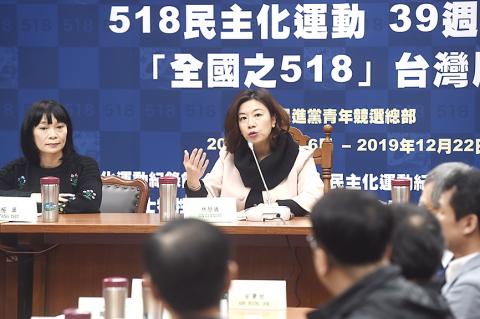An exhibition commemorating South Korea’s Gwangju Uprising opened in Taipei yesterday.
To mark the 39th anniversary of the South Korean pro-democracy movement, as well as the 40th anniversary of Taiwan’s Kaohsiung Incident, the Transitional Justice Commission invited organizers of the Gwangiu exhibition to present it in Taiwan, Democratic Progressive Party (DPP) Legislator Lin Ching-yi (林靜儀) told a news conference.
The Kaohsiung Incident, also known as the Formosa Incident, took place on Dec. 10, 1979, when a demonstration organized by opposition politicians and Formosa Magazine to commemorate Human Rights Day turned violent.

Photo: Chien Jung-fong, Taipei Times
Members of the crowd unknown to the organizers — and widely believed to have been agents provocateurs — began attacking police, which was followed by the then-Chinese Nationalist Party (KMT) government arresting and jailing a group of political dissidents.
The Gwangju Uprising — also called the May 18 Democratic Uprising — against martial law took place in Gwangju, South Korea, in 1980.
More than 200 people died or went missing, official figures showed, while advocates have said that the toll might have been three times higher.
Commission Acting Chairwoman Yang Tsui (楊翠) said that the agency saw the exhibition held by the South Korean National Assembly during a visit in June and was inspired by its efforts in exhibiting historical wounds to create an opportunity for forgiveness and reconciliation.
The exhibition demonstrated how to implement transitional justice at the right pace, she added.
Victims of the uprising have witnessed public apologies by the South Korean government, DPP legislator-at-large nominee Fan Yun (范雲) said, adding that several movies documenting the democratic process and independent reports about the female victims in the uprising have been made.
On the other hand, Taiwan does not have any movie dedicated to the Kaohsiung Incident, let alone independent investigation reports about female victims, she said.
Nor has anyone apologized for the incident and transitional justice has not been achieved, as it remains unanswered who should be held accountable for turning the peaceful protest into a violent uprising, she added.
May 18 Archives researcher Lee Deok-jae said that after martial law was imposed in South Korea, soldiers entered Gwangju and began massacring people.
The uprising gave rise to the pro-democracy movement in South Korea, as its ripple effects spread not only within Gwangju, but across the nation, Lee said.
The 228 Massacre in Taiwan must have been similar, he added.
The 228 Massacre refers to an uprising that was ignited on Feb. 27, 1947, against the then-KMT regime and a resulting crackdown that left tens of thousands of people dead and launched the White Terror era.
May 18 Memorial Foundation Education Culture and Department manager Gwon Hyeok-min said that she was in Gwangju when the uprising started, which was why she can sympathize with victims of the 228 Incident and the Kaohsiung Incident, as she understood how it felt to be called a “rioter.”
Taiwan’s 40-year-long government oppression during the Martial Law era can have devastating effects on the mental health of its victims, Gwon said, expressing the hope that efforts to implement transitional justice could heal the trauma.
The exhibition runs until Dec. 22 at an open space across from the National Audit Office on Taipei’s Hangzhou N Road. Admission is free.

US climber Alex Honnold is to attempt to scale Taipei 101 without a rope and harness in a live Netflix special on Jan. 24, the streaming platform announced on Wednesday. Accounting for the time difference, the two-hour broadcast of Honnold’s climb, called Skyscraper Live, is to air on Jan. 23 in the US, Netflix said in a statement. Honnold, 40, was the first person ever to free solo climb the 900m El Capitan rock formation in Yosemite National Park — a feat that was recorded and later made into the 2018 documentary film Free Solo. Netflix previewed Skyscraper Live in October, after videos

Starting on Jan. 1, YouBike riders must have insurance to use the service, and a six-month trial of NT$5 coupons under certain conditions would be implemented to balance bike shortages, a joint statement from transportation departments across Taipei, New Taipei City and Taoyuan announced yesterday. The rental bike system operator said that coupons would be offered to riders to rent bikes from full stations, for riders who take out an electric-assisted bike from a full station, and for riders who return a bike to an empty station. All riders with YouBike accounts are automatically eligible for the program, and each membership account

NUMBERS IMBALANCE: More than 4 million Taiwanese have visited China this year, while only about half a million Chinese have visited here Beijing has yet to respond to Taiwan’s requests for negotiation over matters related to the recovery of cross-strait tourism, the Tourism Administration said yesterday. Taiwan’s tourism authority issued the statement after Chinese-language daily the China Times reported yesterday that the government’s policy of banning group tours to China does not stop Taiwanese from visiting the country. As of October, more than 4.2 million had traveled to China this year, exceeding last year. Beijing estimated the number of Taiwanese tourists in China could reach 4.5 million this year. By contrast, only 500,000 Chinese tourists are expected in Taiwan, the report said. The report

Temperatures are forecast to drop steadily as a continental cold air mass moves across Taiwan, with some areas also likely to see heavy rainfall, the Central Weather Administration (CWA) said. From today through early tomorrow, a cold air mass would keep temperatures low across central and northern Taiwan, and the eastern half of Taiwan proper, with isolated brief showers forecast along Keelung’s north coast, Taipei and New Taipei City’s mountainous areas and eastern Taiwan, it said. Lows of 11°C to 15°C are forecast in central and northern Taiwan, Yilan County, and the outlying Kinmen and Lienchiang (Matsu) counties, and 14°C to 17°C